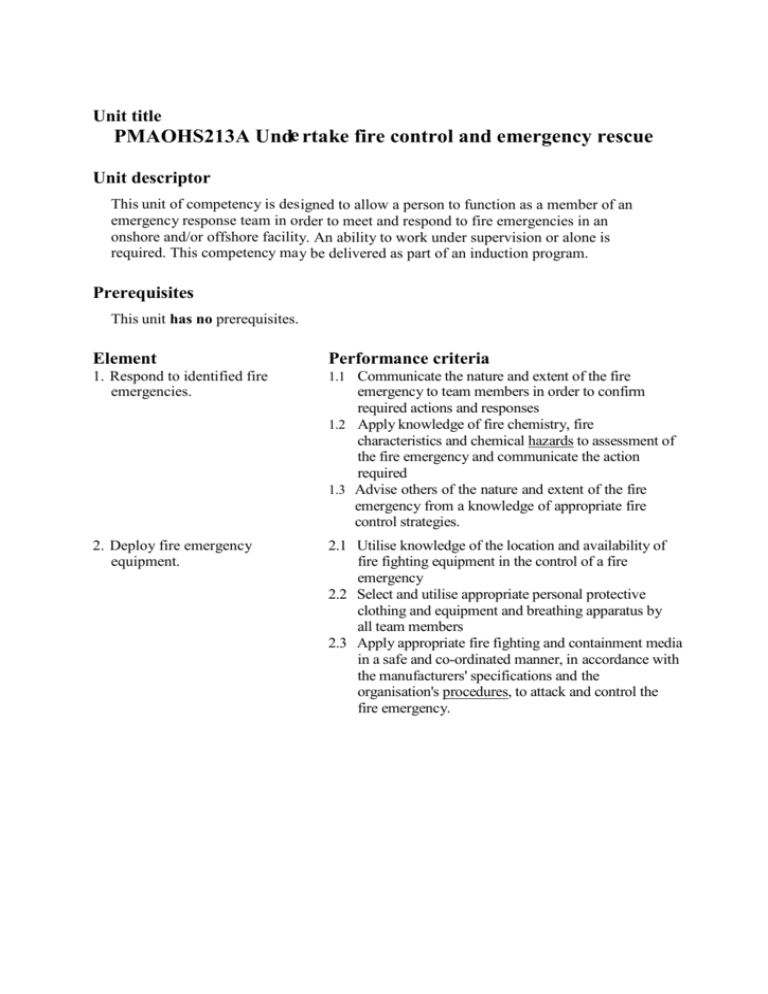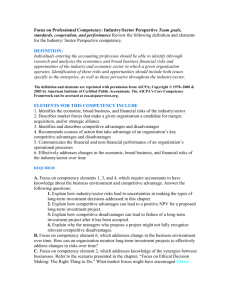e 3. Undertake search of and rescue from affected areas. 3.1 Confir
advertisement

Unit title PMAOHS213A Unde rtake fire control and emergency rescue Unit descriptor This unit of competency is des igned to allow a person to function as a member of an emergency response team in order to meet and respond to fire emergencies in an onshore and/or offshore facility. An ability to work under supervision or alone is required. This competency ma y be delivered as part of an induction program. Prerequisites This unit has no prerequisites. Element Performance criteria 1. Respond to identified fire emergencies. 1.1 Communicate the nature and extent of the fire 2. Deploy fire emergency equipment. 2.1 Utilise knowledge of the location and availability of fire fighting equipment in the control of a fire emergency 2.2 Select and utilise appropriate personal protective clothing and equipment and breathing apparatus by all team members 2.3 Apply appropriate fire fighting and containment media in a safe and co-ordinated manner, in accordance with the manufacturers' specifications and the organisation's procedures, to attack and control the fire emergency. emergency to team members in order to confirm required actions and responses 1.2 Apply knowledge of fire chemistry, fire characteristics and chemical hazards to assessment of the fire emergency and communicate the action required 1.3 Advise others of the nature and extent of the fire emergency from a knowledge of appropriate fire control strategies. 3. Undertake search of and rescue from affected areas. 3.1 Confirm the need to conduct the search and rescue 3.1 3.2 3.3 3.4 3.5 3.6 with team leaders or other nominated personnel Conduct systematic primary and secondary searches Search rooms and mark in accordance with the organisation's procedures Lead occupants to safety Locate injured personnel and transfer them in an appropriate manner to a safe location Minimise the risk of further injury to affected personnel by applying casualty handling techniques and handing them to the care of medical personnel once clear of threat of fire Communicate extent of injuries and casualty numbers to other support groups and request further assistance as required. Range of variables Context This competency would be applied by those persons who as a normal part of the work responsibilities and duties act as members of an emergency response team on an onshore or offshore facility. The person undertaking this competency must be able to work alone and also within an environment which requires a high level of teamwork and interpersonal communication. A person undertaking this unit of competency should be able to respond to directives given either by emergency team leaders or other team members in order to contain and control the emergency. This unit could be applied to any of the following installations or facilities: • onshore/offshore rig/installation • island based facility • floating production platform • onshore production, processing and/or storage facilities • pipeline easements • maintenance bases. • Equipment may include: • fire extinguishing agents and water curtains • hoses • mobile extinguishers • stretchers • personal protective clothing and equipment such as: • chemical protective clothing • distress alarms • structural fire protective clothing • self contained breathing apparatus (SCBA) • communication equipment. Fire extinguishing media may include: • water • foam • extinguishing powder • gaseous extinguishing agents • vapourising liquids • other fire extinguishing substances. On-scene hazards may include: • smoke, darkness and heat • electricity • gas • structural hazards • structural collapse • industrial — machinery, equipment, product • hazardous products and materials • unauthorised personnel. Firefighting strategies and tactics may include: • direct attack • indirect attack • combination attack • exposure protection • internal/offensive attacks • confining the spread of fire • rescuing occupants • cooling the fuels • removal of fuels • interrupting the chemical chain reaction • exclusion of oxygen. HSE All operations to which this unit applies are subject to stringent health, safety and environment requirements, which may be imposed through State or federal legislation, and these must not be compromised at any time. Where there is an apparent conflict between performance criteria and HSE requirements, the HSE requirements take precedence. Evidence guide Assessment context and methods Assessment for this unit of competency will be on an operating plant. The unit will be assessed in as holistic a manner as is practical and may be integrated with the assessment of other relevant units of competency. Assessment will occur over a range of situations which will include disruptions to normal, smooth operation. Simulation may be required to allow for timely assessment of parts of this unit of competency. Simulation should be based on the actual plant and will include walk throughs of the relevant competency components. Simulations may also include the use of case studies/scenarios and role plays. This unit of competency requires a significant body of knowledge which will be assessed through questioning and the use of what if scenarios both on the plant (during demonstration of normal operations and walk throughs of abnormal operations) and off the plant. Critical aspects Competence must be demonstrated in the ability to recognise and analyse potential situations requiring action and then in implementing appropriate corrective action. The emphasis should be on the ability to minimise the effects of the critical situation. Consistent performance should be demonstrated. In particular look for evidence of: • ability to work effectively in a team • recognition of fire behaviour • impact of fire fighting tactics • conducting fire fighting operations in accordance with the organisation’s safe work practices These aspects may be best assessed using a range of scenarios/case studies/what ifs as the stimulus with a walk through forming part of the response. These assessment activities should include a range of problems, including new, unusual and extreme situations which may have been generated from the past incident history of the plant, incidents on similar plants around the world, hazard analysis activities (eg, HAZOP) and similar sources. Resource implications Assessment will require access to an operating plant over an extended period of time, or a suitable method of gathering evidence of operating ability over a range of situations. A bank of scenarios/case studies/what ifs will be required as will a bank of questions which will be used to probe the reasoning behind the observable actions. Other assessment advice In all plants it may be appropriate to assess this unit concurrently with relevant teamwork and communication units. In a major hazard facility, it may be appropriate to assess this unit concurrently with: • PMAOHS200 Participate in workplace safety procedures. Essential knowledge Knowledge and understanding of the process sufficient to recognise fire situations and then determine an action that is appropriate within operating guidelines and the scope of their responsibilities and competencies. It would be expected that a person would be able to communicate with team members the nature and extent of the fire and the actions required. A person undertaking this competency must be able to demonstrate knowledge of: • fire chemistry, fire characteristics and chemical hazards • location and availability of fire fighting equipment • appropriate personal protective clothing, equipment and breathing apparatus • appropriate fire fighting and containment media • casualty handling techniques. Key competencies 1 2 3 4 5 6 7 Collect, analyse and organise information Communicate ideas and information Plan and organise activities Work with others and in teams Use mathematical ideas and techniques Solve problems Use technology 2 2 2 2 1 2 2








